Submit the following programs via Gradescope:
- Due Date: February 14 Think CS: Chapters 1 & 2; Lab1
Write a program that prints "Hello, World!" to the screen.
Hint: See Lab 1.
- Due Date: February 15 Think CS: Chapter 4; Lab 1
Write a program that draws an octagon. Use the sample turtle programs from class to get started.
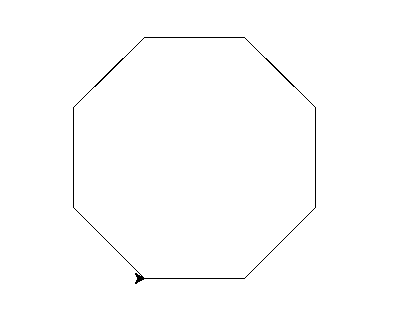
Note: Whenever submitting a turtle program, choose a name for your file that is not turtle.py. When executing the "import turtle" statement, the computer first looks in the folder where the file is saved for the turtle module and then in the libraries (and other places on the path). So, it thinks the module is itself, causing all kinds of errors. To avoid this, name your program something like "myTurtle.py" or "program2.py".Hint: See Lab 1.
- Due Date: February 16 Think CS: Chapter 4; Lab 1
Write a program that implements the pseudocode ("informal high-level description of the operating principle of a computer program or other algorithm") below:
Repeat 36 times: Walk forward 100 steps Turn left 145 degrees Walk forward 10 steps Turn right 90 degrees Walk forward 10 steps Turn left 135 degrees Walk forward 100 steps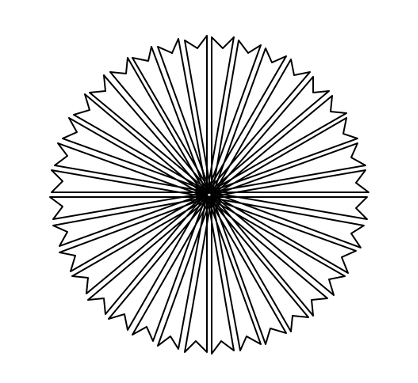
- Due Date: February 20 Think CS: Chapter 2
Write a program that will print "I love Python!" 25 times.
The output of your program should be:
I love Python! I love Python! I love Python! I love Python! I love Python! I love Python! I love Python! I love Python! I love Python! I love Python! I love Python! I love Python! I love Python! I love Python! I love Python! I love Python! I love Python! I love Python! I love Python! I love Python! I love Python! I love Python! I love Python! I love Python! I love Python!
- Due Date: February 21 Think CS: Chapter 4
Write a program that uses the turtle package to draw a 5-pointed star.
Your output should look like this:

Hint: For the 5-pointed star, the turtle turns 2 complete revolutions (720 degrees). How much does the turtle need to turn at each point?
- Due Date: February 22 Think CS: Chapter 2
&
Section 4.4
Write a program that prints out the numbers from 0 to 14.
The output of your program should be:
0 1 2 3 4 5 6 7 8 9 10 11 12 13 14
Hint: Use a loop and print out the index or loop variable.
- Due Date: February 27 Think CS: Chapters 2 & Chapter 9
Using the string commands introduced in Lab 2, write a Python program that prompts the user for a message, and then prints the message, the message in upper case letters, and the message in lower case letters.
A sample run of your program should look like:
Enter a message: Mihi cura futuri Mihi cura futuri MIHI CURA FUTURI mihi cura futuri
Another run:
Enter a message: I love Python! I love Python! I LOVE PYTHON! i love python!
Hint: Your program should be able to take any phrase the user enters and prints it, it in upper case letters, and it in lower case letters. To do that, you need to store the phrase in a variable and print variations of the stored variable.
- Due Date: February 28 Think CS: Chapters 2 & Chapter 9
Write a program that prompts the user to enter a phrase and then prints out the ASCII code of each character in the phrase.
A sample run of your program should look like:
Enter a phrase: I love Python! In ASCII: 73 32 108 111 118 101 32 80 121 116 104 111 110 33
And another sample run:
Enter a phrase: ABC In ASCII: 65 66 67
Hint: If c is a character, ord(c) returns its ASCII code. For example, if c is 'I', then ord(c) returns 73. See Lab 2.
- Due Date: February 29 Think CS: Chapters 2 & Chapter 9

(The cipher disk above shifts 'A' to 'N', 'B' to 'O', ... 'Z' to 'M', or a shift of 13. From secretcodebreaker.com.)Write a program that prompts the user to enter a word and then prints out the word with each letter shifted right by 13. That is, 'a' becomes 'n', 'b' becomes 'o', ... 'y' becomes 'l', and 'z' becomes 'm'.
Assume that all inputted words are in lower case letters: 'a',...,'z'.
A sample run of your program should look like:
Enter a word: zebra Your word in code is: mroen
Hint: See Caesar Cipher example
- Due Date: March 1 Think CS: Chapters 2 & 4
Write a program that implements the pseudocode below:
For i = 5, 10, 15, 20, 25, ... ,300: Walk forward i steps Turn left 91 degreesYour output should look similar to:
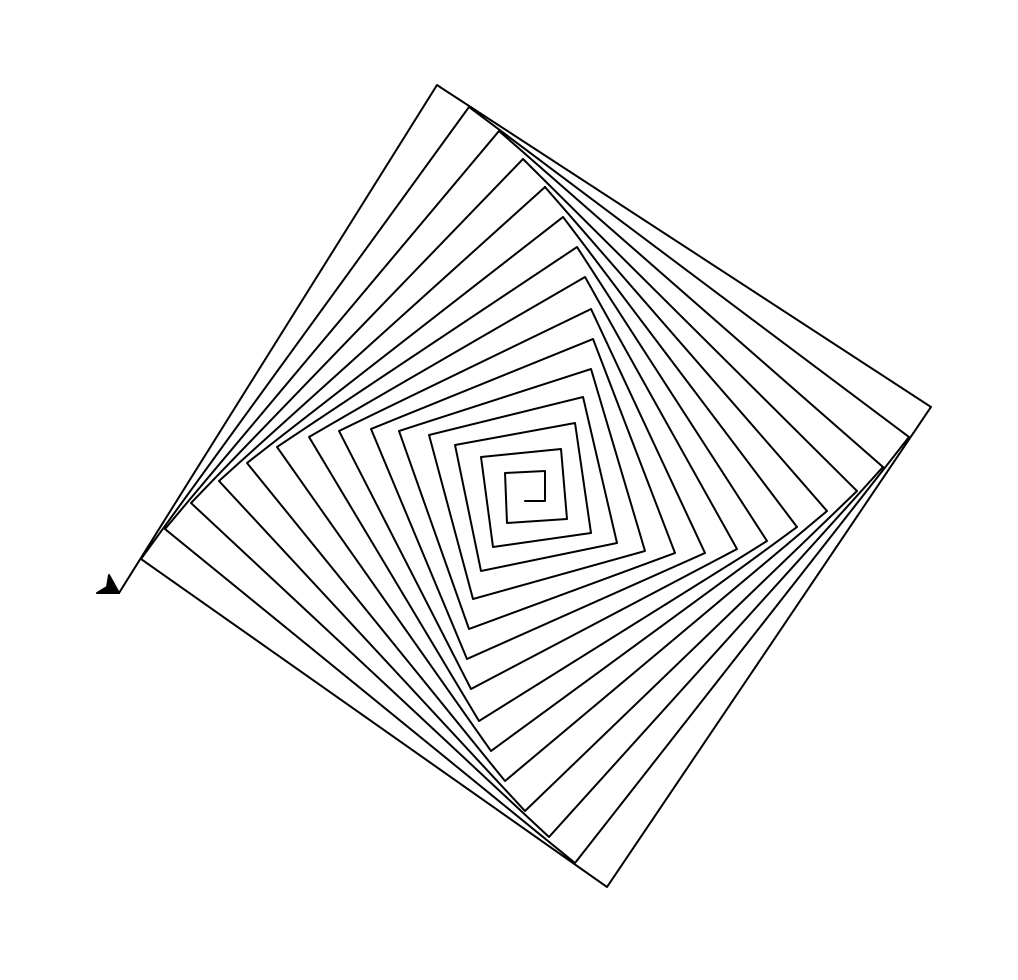
Hint: See examples of range(start,stop,step) in Lecture 2 notes.
- Due Date: March 4 Think CS: Chapters 2 & 4
Modify the program from Lab 3 to show the shades of blue.
Your output should look similar to:
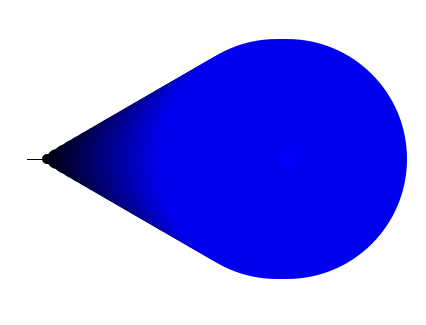
- Due Date: March 5 Think CS: Chapters 2 & 4
Write a program that asks the user for the hexcode of a color and then displays a turtle that color.
A sample run of your program should look like:
Enter a hex string: #A922A9
and the output should look similar to:

Hint: See Section 4.3 for setting the background color and Lab 3 for colors.
- Due Date: March 6 Think CS: Chapters 2 & 4
Draw a cornflower blue pentagon using the turtle module. You can specify the color by name ("cornflowerblue"), by hex string ("#6495ED"), or by RGB values (100, 149, 237). The turtle should be turtle shaped. Your turtle should move forward 100 units, turn left the correct amount of degrees, and then stamp.
A sample run of your program will look like:
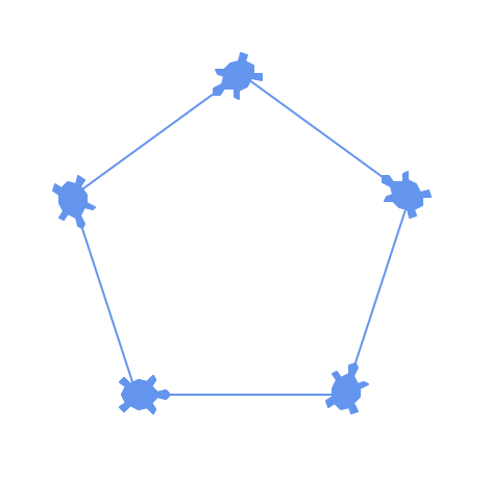
Hint: See Lab 3.
- Due Date: March 7 Think CS: Chapter 2 & Section 8.2
Write a program that asks the user for a message, then prints out that message in reverse. The reversed output message should be printed with two copies of each character per line.
A sample run of your program should look like:
Enter a message: I love Python! ! ! n n o o h h t t y y P P e e v v o o l l I I
Hint: See Lab 2 or Lecture 2 notes.
- Due Date: March 8 Think CS: Chapter 4
Write a program that asks the user for 5 whole (integer) numbers. For each number, turn the turtle left the degrees entered and then the turtle should move forward 100.
A sample run of your program should look like:
Enter a number: 270 Enter a number: 100 Enter a number: 190 Enter a number: 200 Enter a number: 80
and the output should look similar to:
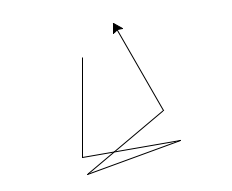
- Due Date: March 11 Think CS: Chapter 2 & Section 8.2
Implement the following piece of pseudocode as a complete program:1. Prompt the user to enter a string and call it s. 2. Let ls be the length of s. 3. For i in 0, 1, ..., ls-1: 4. Print s[:i] 5. For i in 0, 1, ..., ls-1: 6. Print s[i:] 5. Print a closing statementA sample run of your program should look like:
Enter string: a man a plan a canal panama a a a m a ma a man a man a man a a man a a man a p a man a pl a man a pla a man a plan a man a plan a man a plan a a man a plan a a man a plan a c a man a plan a ca a man a plan a can a man a plan a cana a man a plan a canal a man a plan a canal a man a plan a canal p a man a plan a canal pa a man a plan a canal pan a man a plan a canal pana a man a plan a canal panam a man a plan a canal panama man a plan a canal panama man a plan a canal panama an a plan a canal panama n a plan a canal panama a plan a canal panama a plan a canal panama plan a canal panama plan a canal panama lan a canal panama an a canal panama n a canal panama a canal panama a canal panama canal panama canal panama anal panama nal panama al panama l panama panama panama anama nama ama ma a Thank you for using my program!
- Due Date: March 12 Think CS: Chapter 2 & Section 8.2
Create a program that creates a image of purple and yellow stripes. Your program should ask the user for the size of your image, the name of the output file, and create a .png file of stripes. For example, if the user enters 50, your program should create a 50x50 image, alternating between purple and yellow stripes.
Your output should look similar to this:
Enter the size: 50 Enter output file: stripes50.png

Important!! Before submitting your program for grading, remove commands that show the image; any plt.show() and plt.imshow() commands will give an error! The program is graded on a server on the cloud and does not have a graphics window. Instead, the files your program produces are compared pixel-by-pixel to the answer to check for correctness.
Hint: See notes from Lecture 4.
- Due Date: March 13 Think CS: Section 2.7
Write a program that implements the pseudocode below:
1. Ask the user for the number of hours until the weekend. 2. Print out the days until the weekend (days = hours // 24) 3. Print out the leftover hours (leftover = hours % 24)
A sample run of your program should look like:
Enter number of hours: 27 Days: 1 Hours: 3
and another sample run:
Enter number of hours: 52 Days: 2 Hours: 4
Hint: See Section 2.7.
- Due Date: March 14 Think CS: Chapter 2
Write a program that converts kilometers to miles. Your program should prompt the user for the number of kilometers and then print out the number of miles.
A useful formula: miles = 0.621371* kilometers.
Hint: See Lab 4.
- Due Date: March 15 Think CS: Chapter 7 &
Section 8.11
Following Lab 5, write a program that asks the user for the name of a png file and print the number of pixels that are nearly white (the fraction of red, the fraction of green, and the fraction of blue are all above 0.75).
For example, if your file was of the snow pack in the Sierra Nevada mountains in California in September 2014:
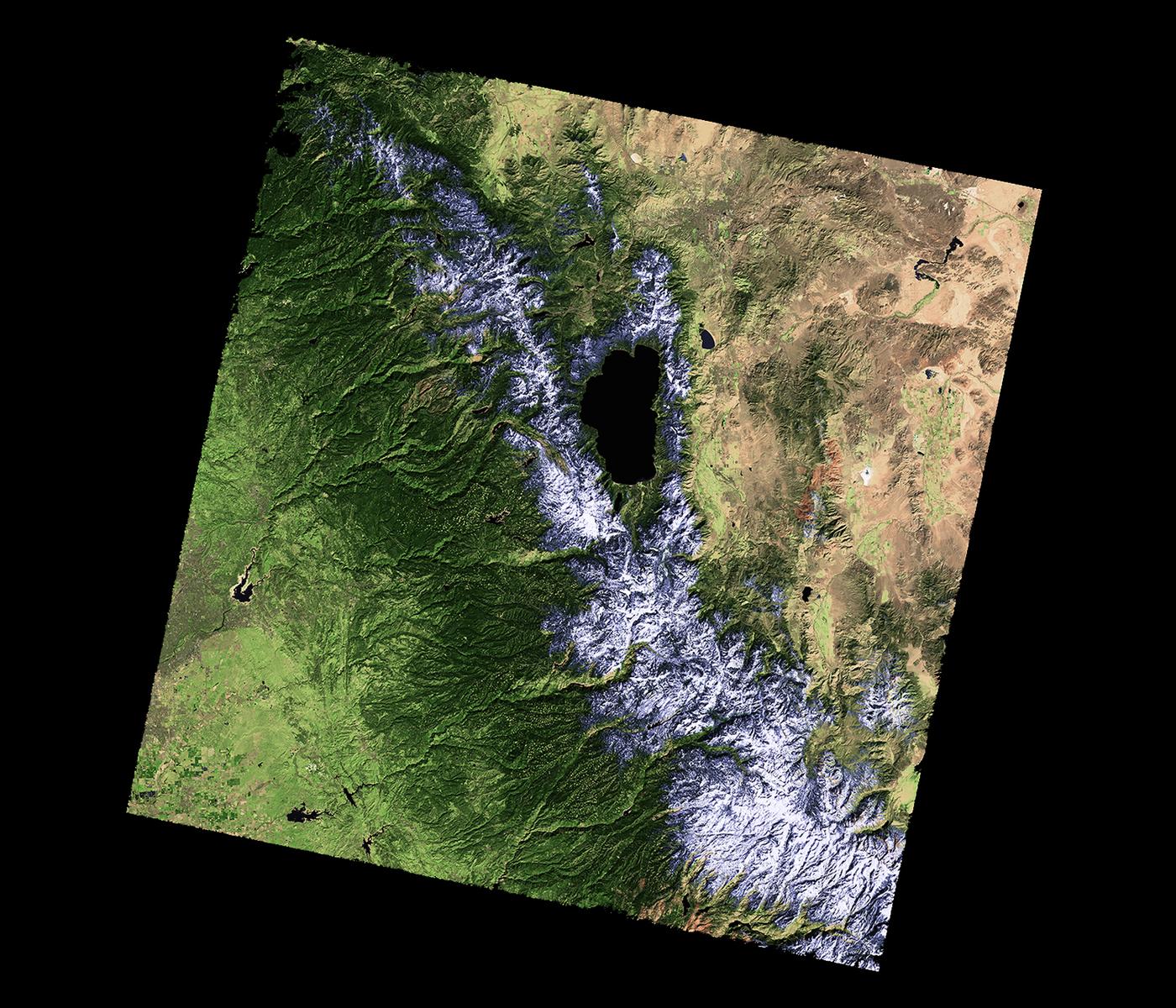
then a sample run would be:
Enter file name: caDrought2014.png Snow count is 38010
Note: for this program, you only need to compute the snow count. Showing the image will confuse the grading script, since it's only expecting the snow count.
- Due Date: March 18 Burch's Logic & Circuits
Write a logical epxression that is equivalent to the circuit that computes the majority of 3 inputs, called in1, in2, in3:
- If two or more of the inputs are True, then your expression should evaluate to True.
- Otherwise (two or more of the inputs are False), then your expression should evaluate to False.
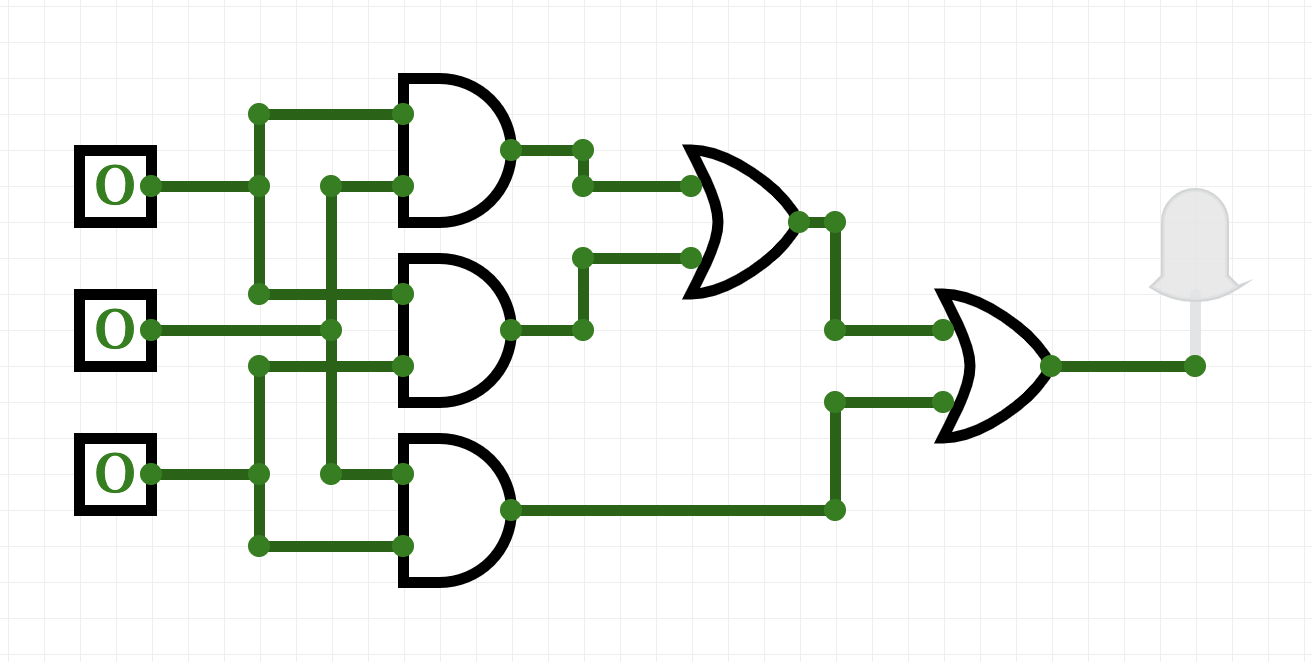
Save your expression to a text file. See Lab 5 for the format for submitting logical expressions to Gradescope.
- Due Date: March 19 Burch's Logic & Circuits
Build a circuit that has the same behavior as a nand gate (i.e. for the same inputs, gives identical output) using only and, or, and not gates.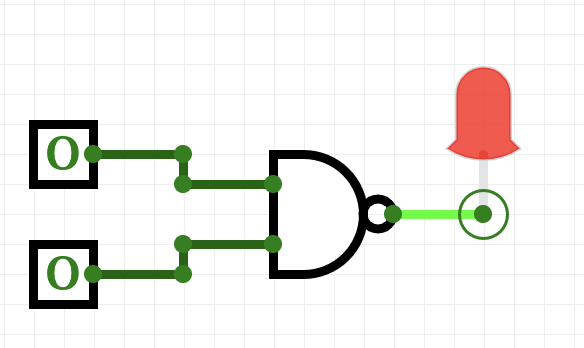
Save your expression to a text file. See Lab 5 for the format for submitting logical expressions to Gradescope.
- Due Date: March 20 Think CS:
Section 10.25
Write a program that asks the user for a list of nouns (separated by spaces) and approximates the fraction that are plural by counting the fraction that end in "s". Your program should output the total number of words and the fraction that end in "s". Assume that words are separated by spaces (and ignore the possibility of tabs and punctuation between words.)
A sample run of the program:
Enter nouns: apple bananas cantalopes durian Number of words: 4 Fraction of your list that is plural is 0.5
And another sample run of the program:
Enter nouns: hats gloves coats glasses scarves Number of words: 5 Fraction of your list that is plural is 1.0
Hint: Break this problem into pieces:
- First, count the number of words in the string the user entered (hint: count the number of spaces). Print out the number of words. Make sure this works before going onto the next part.
- Next, ignoring the last word (which is a special case and can be dealt with separately), count the number of words ending in 's' (hint: count the number of "s "). Test that this part works before going on to the next step.
- Last, check the last word to see if it ends in "s"-- since it's the last word, the "s" will always occur at the same index in the string.
- Due Date: March 21 Think CS: Chapter 4 & Section 7.4
The program turtleString.py takes a string as input and uses that string to control what the turtle draws on the screen (inspired by code.org's graph paper programming). Currently, the program processes the following commands:
- 'F': moves the turtle forward 50 steps
- 'L': turns the turtle 90 degrees to the left
- 'R': turns the turtle 90 degrees to the right
- '^': lifts the pen
- 'v': lowers the pen
Modify this program to allow the user also to specify with the following symbols:
- 'B': moves the turtle backwards 50 steps
- 'S': makes the turtle stamp
- 'l': turns the turle 45 degrees to the left
- 'r': turns the turtle 45 degrees to the right
- 'p': change the pen color to purple
Hint: See Lecture 4 notes.
- Due Date: March 22 Burch's Logic & Circuits
Build a circuit that has the same behavior as a nor gate (i.e. for the same inputs, gives identical output) using only and, or, and not gates.
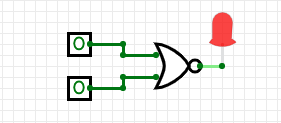
Save your expression to a text file. See Lab 5 for the format for submitting logical expressions to Gradescope.
- Due Date: March 25 10-mins to Pandas, DataCamp Pandas
Modify the program from Lab 6 that displays the NYC historical population data. Your program should ask the user for the borough, an name for the output file, and then display the fraction of the population that has lived in that borough, over time.
A sample run of the program:
Enter borough name: Queens Enter output file name: qFraction.png
The file qFraction.png:
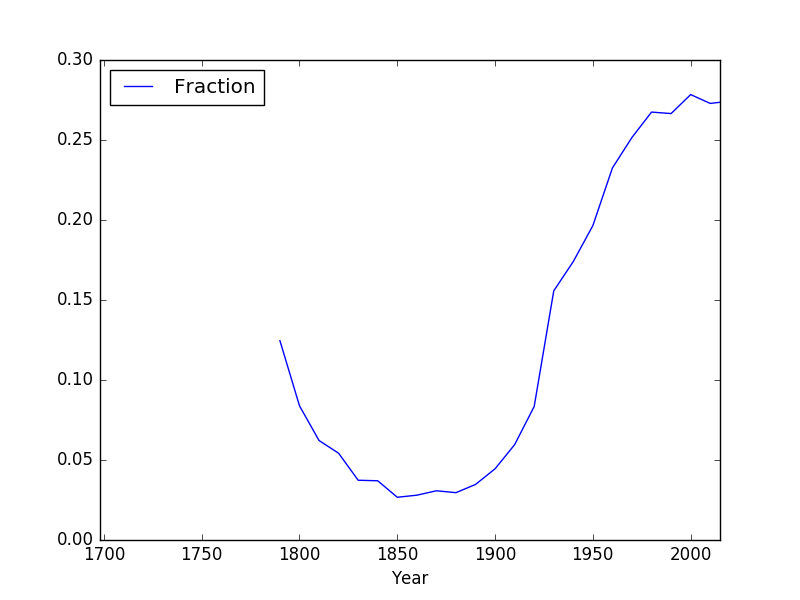
Important!! Before submitting your program for grading, remove commands that show the image; any plt.show() and plt.imshow() commands will give an error! The program is graded on a server on the cloud and does not have a graphics window.
- Due Date: March 26 10-mins to Pandas, DataCamp Pandas
Write a program that computes the average and maximum population over time for a borough (entered by the user). Your program should assume that the NYC historical population data file, nycHistPop.csv is in the same directory.
A sample run of your program:
Enter borough: Staten Island Average population: 139814.23076923078 Maximum population: 474558
and another run:
Enter borough: Brooklyn Average population: 1252437.5384615385 Maximum population: 2738175
Hint: See Lab 6
If you are getting errors, check the following:- Use skiprows=5 when reading in the data
- Print out the labels when printing the average and maximum values (follow the sample output exactly)
Example: print("Average population:", average)
- Due Date: March 27
Ubuntu Terminal Reference Sheet
Write an Unix shell script that prints Hello, World to the screen.
Submit a single text file containing your shell commands. See Lab 6 for details.
- Due Date: March 28
GitHub Guide
In Lab 6, you created a GitHub account. Submit a text file with the name of your account. The grading script is expecting a file with the format:
#Name: Your name #Date: October 2023 #Account name for my GitHub account AccountNameGoesHere
Note: it takes a few minutes for a newly created GitHub account to be visible. If you submit to Gradescope and get a message that the account doesn't exist, wait a few minutes and try again.
- Due Date: March 29 10-mins to Pandas, DataCamp Pandas
Modify the program from Lab 7 that displays shelter population over time to:
- ask the user to specify the input file,
- ask the user to specify the output file,
- make a plot of the fraction of the total population that are children over time from the data in input file, and
- store the plot in the output file the user specified.
A sample run of the program:
Enter name of input file: DHS_Daily_Report.csv Enter name of output file: dhsPlot.png
which produces an output:

Note: The grading script is expecting that the label (i.e. name of your new column) is "Fraction Children".
Important!! Before submitting your program for grading, remove commands that show the image; any plt.show() and plt.imshow() commands will give an error! The program is graded on a server on the cloud and does not have a graphics window.
- Due Date: April 1 Think CS Section 6.8
Write a program, using a function main() that prints "Hello, World!" to the screen. See Lab 7.
- Due Date: April 2 Think CS Chapter 6 and Chapter 7
Write a program that asks the user for the name of an image, the name of an output file. Your program should then save the lower left quarter of the image to the output file specified by the user.
A sample run of your program should look like:
Enter image file name: hunterLogo.png Enter output file: logoLL.png
which would have as input and output:


Hint: See example program from Lecture 6
Important!! Before submitting your program for grading, remove commands that show the image; any plt.show() and plt.imshow() commands will give an error! The program is graded on a server on the cloud and does not have a graphics window. Instead, the files your program produces are compared pixel-by-pixel to the answer to check for correctness.
- Due Date: April 3 Section 10.25
Write a program that prompts the user to enter a list of names. Each person's name is separated from the next by a semi-colon and a space ('; ') and the names are entered lastName, firstName (i.e. separated by ', '). Your program should then print out the names, one per line, with the first names first followed by the last names.
A sample run of your program should look like:
Please enter your list of names: Epstein, Susan; St. John, Katherine; Vazquez-Abad, Felisa; Xu, Jia; Zamfirescu, Christina You entered: Susan Epstein Katherine St. John Felisa Vazquez-Abad Jia Xu Christina Zamfirescu Thank you for using my name organizer!Hint: See Section 10.25 for a quick overview of split(). Do this problem in parts: first, split the list by person (what should the delimiter be?). Then, split each of person's name into first and last name (what should the delimiter be here?).
- Due Date: April 4 Think CS: Section 7.4
Write a program that asks the user for the hour of the day (in 24 hour time), and prints
- "Good Morning" if it is strictly before 12,
- "Good Afternoon" if it is 12 or greater, but strictly before 17, and
- "Good Evening" otherwise.
A sample run:
Enter hour (in 24 hour time): 11 Good Morning
Another sample run:
Enter hour (in 24 hour time): 20 Good Evening
And another run:
Enter hour (in 24 hour time): 15 Good Afternoon
- Due Date: April 5 10-mins to Pandas, DataCamp Pandas
Modify the parking ticket program from Lab 8 to do the following:
- Ask the user for the name of the input file.
- Ask the user for the attribute (column header) to search by.
A sample run:
Enter file name: tickets.csv Enter attribute: Vehicle Color The 10 worst offenders are: Vehicle Color WHITE 156 GY 112 BK 104 BLACK 103 WH 91 GREY 55 BLUE 53 SILVE 49 RED 43 BL 40 Name: count, dtype: int64
And another run:
Enter file name: tickets.csv Enter attribute: Vehicle Year The 10 worst offenders are: Vehicle Year 0 466 2015 97 2013 85 2014 78 2012 32 2011 31 2010 29 2008 24 2005 22 2004 19 Name: count, dtype: int64
- Due Date: April 12 Reading: Lab 5
Logical gates can be used to do arithmetic on binary numbers. For example, we can write a logical circuit whose output is one more than the inputted number. Our inputs are in1 and in2 and the outputs are stored in out1, out2, and out3.

Here is a table of the inputs and outputs:
Inputs Outputs Decimal
Numberin1 in2 Decimal
Numberout1 out2 out3 0 0 0 1 0 0 1 1 0 1 2 0 1 0 2 1 0 3 0 1 1 3 1 1 4 1 0 0 Submit a text file with each of the outputs on a separate line:
#Name: YourNameHere #Date: November 2023 #Logical expressions for a 4-bit incrementer out1 = ... out2 = ... out3 = ...
Where "..." is replaced by your logical expression (see Lab 5).Note: here's a quick review of binary numbers.
- Due Date: April 12 Reading: Think CS Chapter 6
Fill in the missing function, monthString(), in the program, month.py (available on GitHub here). The function should take number between 1 and 12 as a parameter and returns the corresponding month as a string. For example, if the parameter is 1, your function should return "January". If the parameter is 2, your function should return "February", etc.
Note: The grading scripts are expecting that your function is called monthString(). You need to use that name, since instead of running the entire program, the scripts are "unit testing" the function-- that is, calling that function, in isolation, with differrent inputs to verify that it performs correctly.
Hint: See notes from Lecture 7 and Lab 8.
- Due Date: April 12 Reading: 10-mins to Pandas, DataCamp Pandas
Write a program that asks the user for a CSV of collision data (see note below about obtaining reported collisions from NYC OpenData). Your program should then list the top three contributing factors for the primary vehichle of collisions ("CONTRIBUTING FACTOR VEHICLE 1") in the file.
A sample run:
Enter CSV file name: collisions.csv Top three contributing factors for collisions: CONTRIBUTING FACTOR VEHICLE 1 Driver Inattention/Distraction 1127 Unspecified 1083 Failure to Yield Right-of-Way 351 Name: count, dtype: int64
This assignment uses collision data collected and made publicly by New York City Open Data, and can be found at:
https://data.cityofnewyork.us/Public-Safety/NYPD-Motor-Vehicle-Collisions/h9gi-nx95.
Since the files are quite large, use the "Filter" option and choose your birthday in 2022 and "Export" (in CSV format) all collisions for that day. We will use this data set for future programs, so, instead of downloading the test files multiple times, save a copy for future use.Hint: See Lab 8 for accessing and analyzing structured data.
- Due Date: April 12 Reading: Think CS Chapter 6
Write two functions, triangle() and nestedTriangle(). Both functions take two parameters: a turtle and an edge length. The pseudocode for triangle() is:
triangle(t, length): 1. If length > 10: 2. Repeat 3 times: 3. Move t, the turtle, forward length steps. 4. Turn t left 120 degrees. 5. Call triangle with t and length/2.The pseudocode for nestedTriangle() is very similar:
nestedTriangle(t, length): 1. If length > 10: 2. Repeat 3 times: 3. Move t, the turtle, forward length steps. 4. Turn t left 120 degrees. 5. Call nestedTriangle with t and length/2.A template program, nestingTrianges.py, is available here on GitHub. The grading script does not run the whole program, but instead tests your function separately ('unit tests') to determine correctness. As such, the function names must match exactly (else, the scripts cannot find it). Make sure to use the function names from the GitHub program (it is expecting triangle() and nestedTriangle()).
A sample run:
Enter edge length: 160
which would produce:
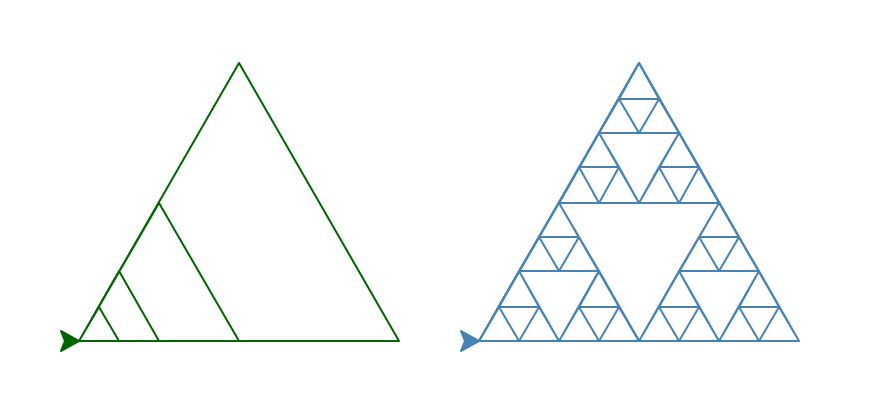
- Due Date: April 12 Reading: Think CS: Chapter 6
Write a function, computeFare(), that takes as two parameters: the zone and the ticket type, and returns the Long Island Railroad fare.
- If the zone is 1 and the ticket type is "peak", the fare is 8.75.
- If the zone is 1 and the ticket type is "off-peak", the fare is 6.25.
- If the zone is 2 or 3 and the ticket type is "peak", the fare is 10.25.
- If the zone is 2 or 3 and the ticket type is "off-peak", the fare is 7.50.
- If the zone is 4 and the ticket type is "peak", the fare is 12.00.
- If the zone is 4 and the ticket type is "off-peak", the fare is 8.75.
- If the zone is 5, 6, or 7 and the ticket type is "peak", the fare is 13.50.
- If the zone is 5, 6, or 7 and the ticket type is "off-peak", the fare is 9.75.
- If the zone is greater than 8, return a negative number (since your calculator does not handle inputs that high).
A template program, LIRRtransit.py, is available here on GitHub. The grading script does not run the whole program, but instead tests your function separately ('unit tests') to determine correctness. As such, the name of the function must match exactly (else, the scripts cannot find it).
A sample run:
Enter the number of zones: 4 Enter the ticket type (peak/off-peak): off-peak The fare is 8.75
And another:
Enter the number of zones: 6 Enter the ticket type (peak/off-peak): peak The fare is 13.5
Hint: See Lab 8.
- Due Date: April 15 Reading: Folium Tutorial
Write a program that uses folium to make a map of New York City. Your map should be centered at (40.75, -74.125) and include a marker for the main campus of Hunter College. The HTML file your program creates should be called: nycMap.html
Hint: See Lab 9.
- Due Date: April 16
Reading: Folium Tutorial
Using folium (see Lab 9), write a program that asks the user for the name of a CSV file, name of the output file, and creates a map with markers for all the traffic collisions from the input file. You can use the same dataset from Problem 38.
A sample run:
Enter CSV file name: collisions.csv Enter output file: myMap.html
which would produce the HTML file:
(The demo above is for March 18, 2016 using the time the collision occurred ("TIME") to label each marker and changed the underlying map with the option: tiles="Cartodb Positron" when creating the map. When submitting to Gradescope, only specify the location of the marker; do not add any labels.)
When running your program locally, you need to check that the "LATITUDE" and "LONGITUDE" values are non-empty. To do this, first we fill the empty values with zeros using the fillna(0) function. Then in our loop, we should only add markers to the map when the values are not zero. You can use this file to get started.
Note: For this data set, the names of the columns are "LATITUDE" and "LONGITUDE" (unlike the previous map problem, where the data was stored with "Latitude" and "Longitude").
- Due Date: April 17
Reading: Think CS: Chapter 3
The program, errorsHex.py, has lots of errors. Fix the errors and submit the modified program.
Hint: See Lab 9.
- Due Date: April 18
Reading: Think CS: Chapter 6 and Folium Tutorial
Fill in the following functions in a program that maps GIS data from NYC OpenData CSV files and marks the current location and closest point:
- getData() that asks the user for the name of the CSV and returns a dataframe of the contents.
- getColumnNames() that asks the user for the exact name of the columns that contains the latitude and longitude and returns those values as a tuple. Since the NYC OpenData files use different names for the columns in different datasets (such as "Lat", "Latitude", "LATITUDE" for latitude), the program asks for the name of the column as well as the name of the data file.
- getLocale() asks the user for latitude and longitude of the user's current location and returns those floating points numbers.
- computeDist() that computes the squared distance
between two points (x1,y1) and (x2,y2):
(x1-x2)2 + (y1-y2)2
A sample run to find the closest CUNY campus to the Brooklyn Navy Yard:
Enter CSV file name: cunyLocations.csv Enter column name for latitude: Latitude Enter column name for longitude: Longitude Enter current latitude: 40.7021 Enter current longitude: -73.9708 Enter output file: closestCUNY.html
which would produce the html file:
A template program, closestPoint.py, is available here on GitHub. The grading script does not run the whole program, but instead runs each of your functions separately ('unit tests') to determine correctness. As such, the names of the functions must match exactly the ones listed above (else, the scripts cannot find them).
Hint: See Lab 9.
- Due Date: April 19 Reading: Think CS: Chapter 6
Fill in the missing functions:
- average(region): Takes a region of an image and returns the average red, green, and blue values across the region.
- setRegion(region,r,g,b): Takes a region of an image and red, green, and blue values, r, g, b. Sets the region so that all points have red values of r, green values of g, and blue values of b.
The functions are part of a program that averages smaller and smaller regions of an image until the underlying scene is visible (inspired by koalas to the max).
For example, if you inputted our favorite image, you would see (left to right):
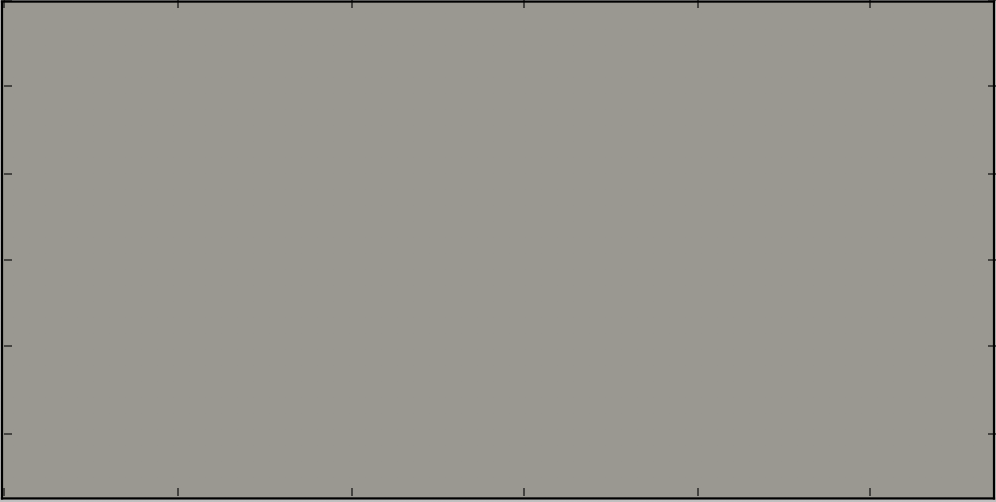

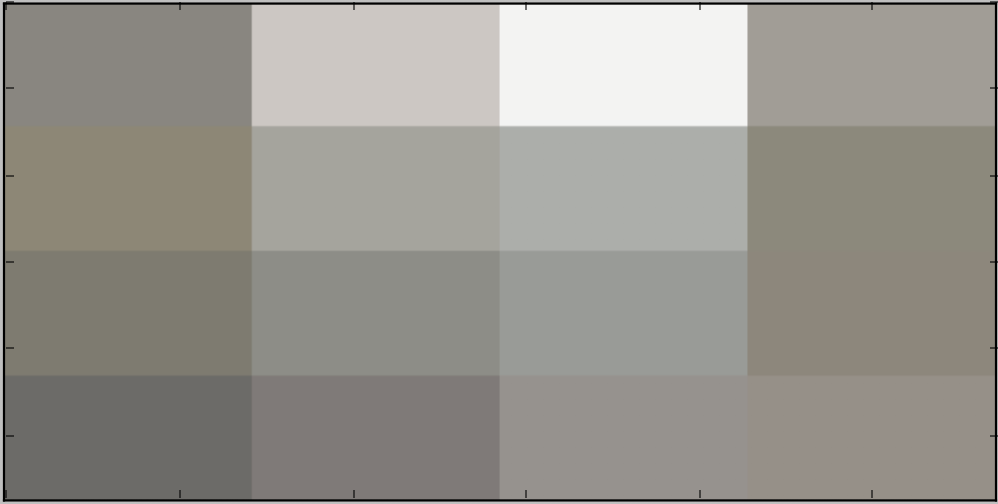

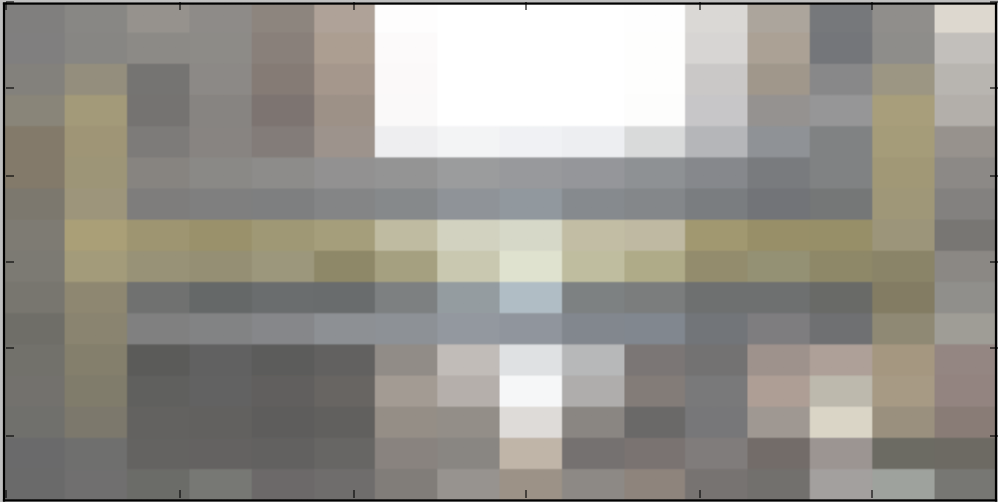
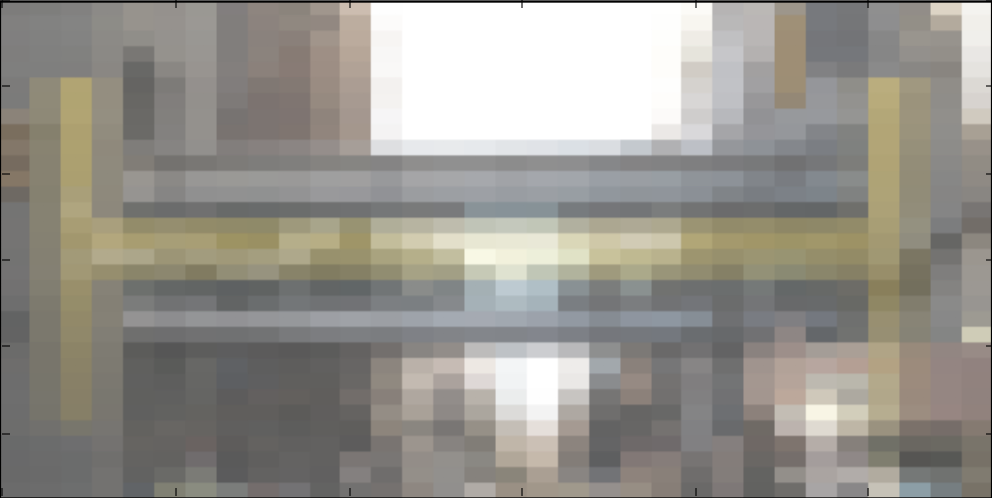
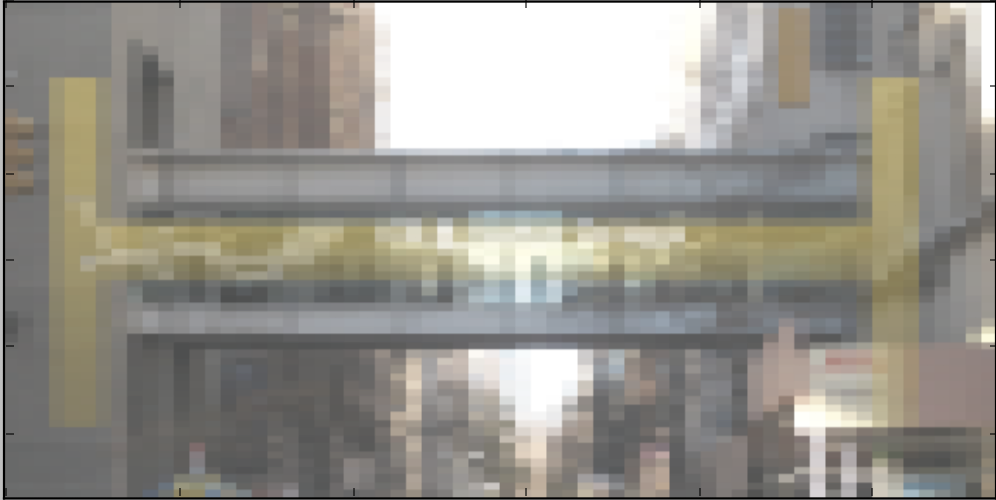
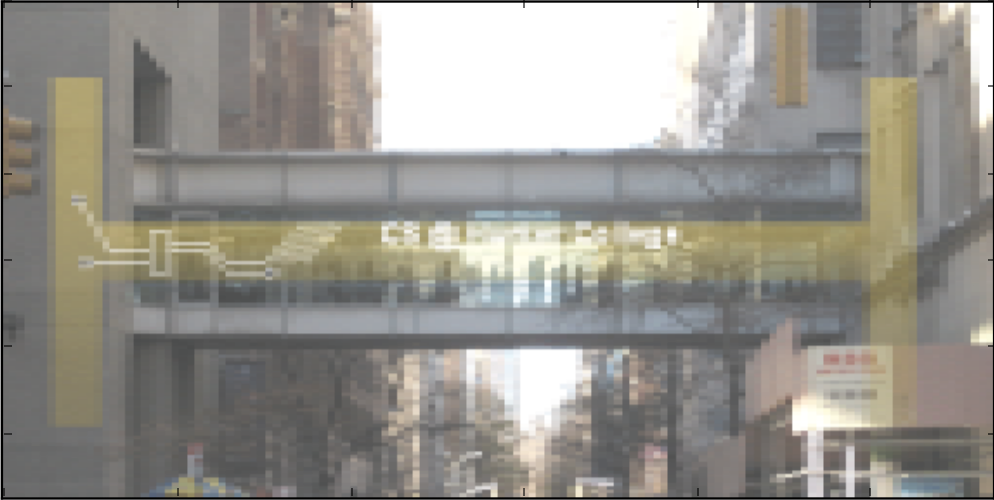
and finally:
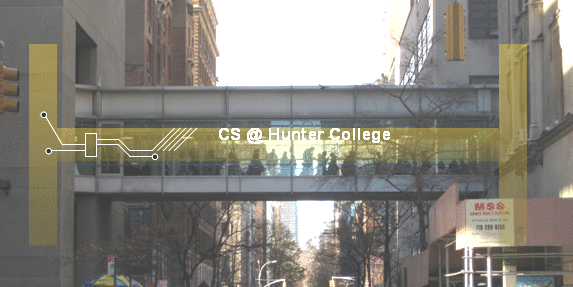
A template program, averageImage.py, is available here on GitHub. The grading script does not run the whole program, but instead runs each of your functions separately ('unit tests') to determine correctness. As such, the names of the functions must match exactly the ones listed above (else, the scripts cannot find them).
Hint: See notes from Lecture 8.
- Due Date: April 22 Reading: Chapter 8
Modify the program from Lab 10 that makes a turtle walk 100 times. Each "walk" is 10 steps forward and the turtle can turn 0,1,2,...,359 degrees (chosen randomly) at the beginning of each walk.
A sample run of your program:
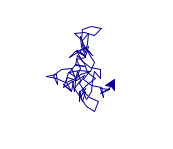
- Due Date: April 23 Reading: Chapter 8
Write a program that asks the user to enter a string. If the user enters an empty string, your program should continue prompting the user for a new string until they enter a non-empty string. Your program should then print out the string entered.
A sample run of your program:
Enter a non-empty string: That was empty. Try again. Enter a non-empty string: That was empty. Try again. Enter a non-empty string: Mihi cura futuri You entered: Mihi cura futuri
- Due Date: April 24
Reading: MIPS Wikibooks
Write a simplified machine language program that prints: Hello, World!
See Lab 11 for details on submitting the simplified machine language programs.
Hint: You may find the following table useful:
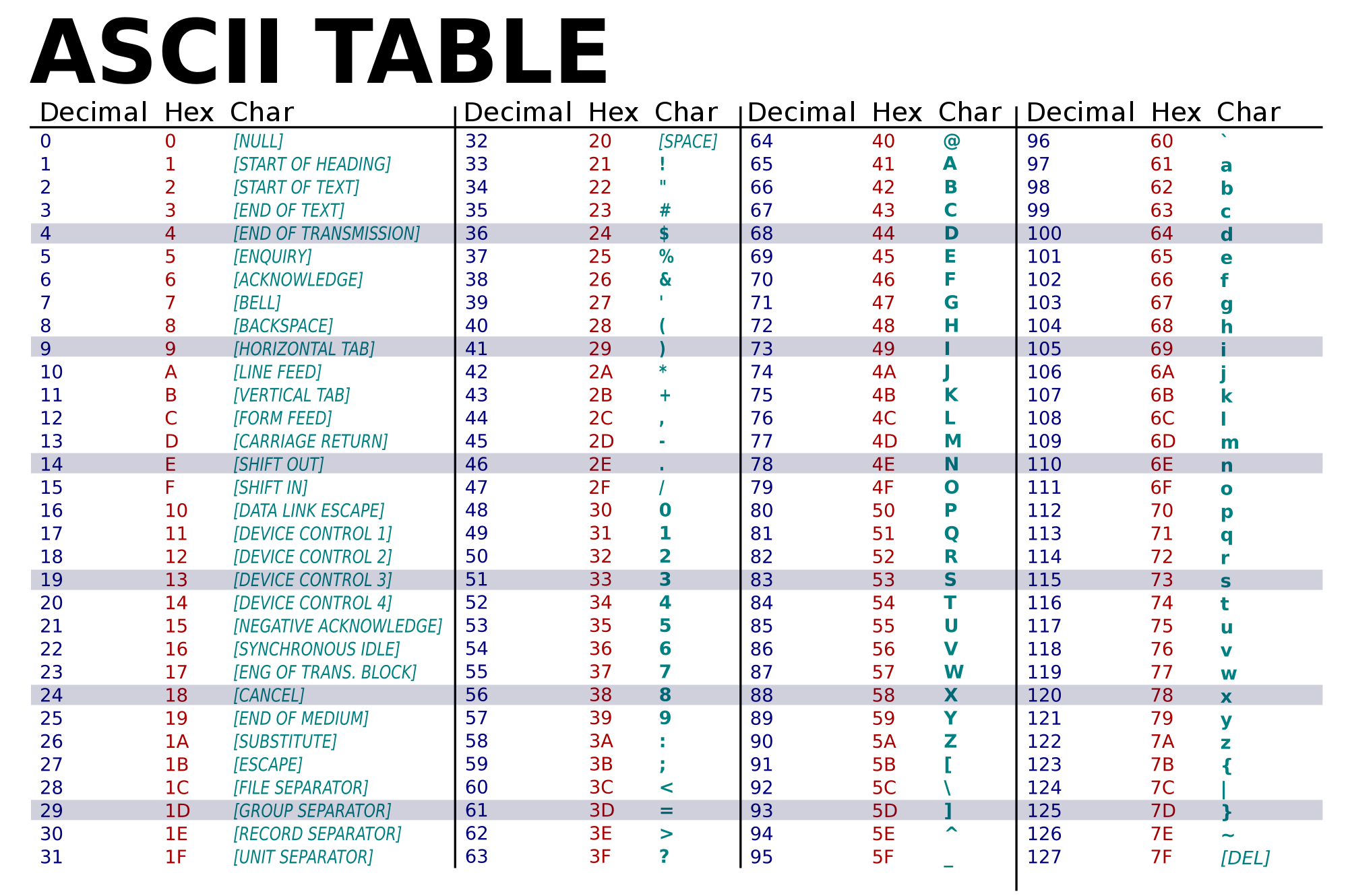
(Image from wikimedia commons)Hint: The grading scripts are matching the phrase exactly, so, you need to include the spacing and punctuation.
- Due Date: May 6 Reading: MIPS Wikibooks
Write a simplified machine language program that has register $s0 loop through the numbers 0, 5, 10, ..., 50.
See Lab 11 for details on submitting the simplified machine language programs.
- Due Date: May 7 Reading: Ubuntu Terminal Reference Sheet
Write an Unix shell script that does the following:
- Creates a directory, projectFiles.
- Creates 3 additional directories (as subdirectories of projectFiles): source, data, and results.
Hint: See Lab 10.
- Due Date: May 8 Reading:
Ubuntu Terminal Reference Sheet
Using Unix shell commands, write a script that counts the number of .py files in current working directory.
Hint: See Lab 11.
- Due Date: May 9 Reading: Cplusplus Tutorial
Write a C++ program that prints "Hello, World!" and "Hello, C++!" in two separate lines to the screen.
Hint: See Lab 12 for getting started with C++.
- Due Date: May 10 Reading: Cplusplus Tutorial
Write a C++ program that will print "Mihi cura futuri" 10 times.
The output of your program should be:
Mihi cura futuri Mihi cura futuri Mihi cura futuri Mihi cura futuri Mihi cura futuri Mihi cura futuri Mihi cura futuri Mihi cura futuri Mihi cura futuri Mihi cura futuri
Hint: See Lab 12 for getting started with C++.
- Due Date: May 13 Reading: Cplusplus Tutorial
Write a C++ program that converts kilometers to miles. Your program should prompt the user for the number of kilometers and then print out the number of miles.
A useful formula: miles = 0.621371* kilometers.
See Lab 4 for designing Input-Process-Output programs and Lab 12 for getting started with C++.
- Due Date: May 14 Reading: Cplusplus Tutorial
Write a C++ program program that asks the user for a number and draws a triangle of that height and width using 'character graphics'.
A sample run:
Enter a number: 6 * ** *** **** ***** ******
Another sample run:
Enter a number: 3 * ** ***
- Due Date: May 15 Reading: Cplusplus Tutorial
Write a C++ program that asks the user for the month of the year (as a number), and prints
- "Happy Winter" if it is strictly before 3 or strictly larger than 11,
- "Happy Spring" if it is 3 or greater, but strictly before 7, and
- "Happy Summer" if it is 7 or greater, but strictly before 9, and
- "Happy Fall" otherwise.
A sample run:
Enter month (as a number): 12 Happy Winter
Another sample run:
Enter month (as a number): 8 Happy Summer
And another run:
Enter month (as a number): 11 Happy Fall
- Due Date: May 16 Reading: Cplusplus Tutorial
Write a C++ program that asks the user for a year, and continue asking until the number entered that is 2018 or earlier.
A sample run:
Enter year: 2023 Year must be 2018 or earlier Enter year: 2025 Year must be 2018 or earlier Enter year: 2000 You entered: 2000
Hint: See Lab 10 for similar programs in Python. Rewrite in C++.
- Due Date: May 17 Reading: Cplusplus Tutorial
Write a complete C++ program that prints the change in population of the the United States:
p = p + Bp - Dpwhere p is the population, B is the birth rate of 12.4 births for every 1000 people (12.4/1000) each year, and D is the death rate of 8.4 for every 1000 people (8.4/1000). In 2017, the population of United States was 325.7 million. Your program should ask the user for the number of years and print expected population over those years starting from 2017. Each line should have: the year and the population (in millions).A sample run:
Please enter the number of years: 10 Year 2017 325.70 Year 2018 327.00 Year 2019 328.31 Year 2020 329.62 Year 2021 330.94 Year 2022 332.27 Year 2023 333.60 Year 2024 334.93 Year 2025 336.27 Year 2026 337.61
- Due Date: May 20 Reading: Cplusplus Tutorial
Write a C++ program that asks the user for a whole number between -31 and 31 and prints out the number in "two's complement" notation, using the following algorithm:
- Ask the user for a number, n.
- If the number is negative, print a 1 and let x = 32 + n.
- If the number is not negative, print a 0 and let x = n.
- Let b = 16.
- While b > 0.5:
- If x >= b then print 1, otherwise print 0
- Let x be the remainder of dividing x by b.
- Let b be b/2.
- Print a new line ('\n').
A sample run:
Enter a number: 8 001000
Another run:
Enter a number: -1 111111